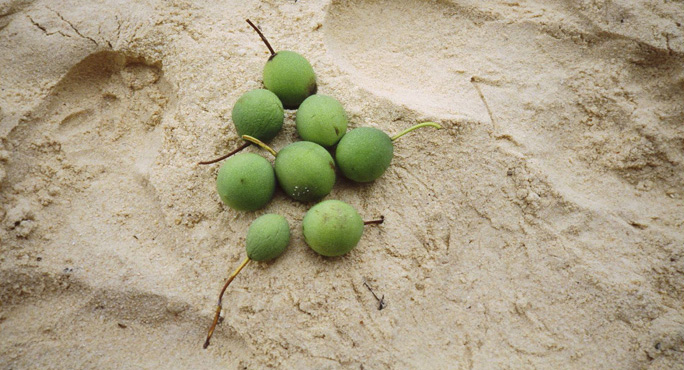Tamanu fruits, Vanuatu South Pacific. Photo by Chris Kilham
When you stop to think about your skin, there are two important facts to bear in mind. One, it’s the largest organ of your entire body, and two, it’s all over you. Men and women alike want healthy skin, and this is amply proven by the huge amounts of cosmetics and skin care products sold globally every year. According to cosmetic industry trade groups, global cosmetic and toiletry sales exceeded 333$ Billion last year, and are expected to grow. Additionally, in the highly competitive skin care business, natural ingredients are faring very well, with sales of truly natural cosmetics topping 8 billion dollars in the U.S. alone.
You don’t really have to spend big on skin preparations. This may sound like heresy to many, but a few herbal agents can do a world of good for your skin, and can help to greatly improve its strength, cellular health and firmness overall.
Witch Hazel
First off, a personal confession that I have splashed witch hazel on my face daily since I was a little boy. This refreshing liquid is distilled from the bark and leaves of witch hazel shrubs (Hamamelis), which are especially abundant in Connecticut. My dad used Dickinson’s Witch Hazel as an after shave skin bracer. I still do. Witch hazel is an astringent; it tightens skin and makes it more firm. Wash your face and then splash on witch hazel, and your skin will gain a healthy glow. Except when I apply topical remedies for bites, etc., witch hazel is the only thing I use on my skin besides water. It is inexpensive, and a bottle will last for months.
Chamomile
This little daisy-like lawn flower (Anthemis nobilis) has been used for centuries as an herbal tea for calming and for promoting sleep. Chamomile is given to babies with colic, and many a mother has quieted a child with a cup of this tea. It is unquestionably one of the most popular herbs of all time. But chamomile also demonstrates benefits to skin. It contains among other things a compound called alpha-bisobolol, which reduces the appearance of fine wrinkles. In other words, it makes your skin look younger, and provides excellent antioxidant protection to cells. You can get a chamomile-based preparation like CamoCare, or make a cup of strong chamomile tea and apply it as a face wash. You can also apply chamomile tea bags onto your skin after you have made the tea.
Tamanu Oil
This tropical nut oil (Calophyllum inophyllum) from the Pacific islands has taken off like a rocket, due to some major media and increased awareness of its unique properties. Tamanu oil has antioxidant properties, so it helps to protect skin cells. It is potently anti-inflammatory, so it benefits sensitive or irritated skin. It’s pretty much the single best thing for burns of any kind. It has cicatrizing properties, which means that it causes the formation of new healthy skin tissue. And as an additional benefit, it kills pimples fast and radically speeds up their healing. A little bit of nutty-smelling tamanu oil goes a long way. Just a thin smear on your skin- anywhere- will make it healthier, smoother. Tamanu is both a beautifier and a first aid product. I never ever travel without tamanu oil. It is indispensible for treating bites, stings, cuts, abrasions, and any kind of bad thing that can happen to skin.
Dragon's Blood (Sangre de Grado)
This is first aid pure and simple. But it’s also starting to make its way into exotic cosmetic preparations around the world. From the Amazon rainforest, Dragon’s blood (Croton lechleri) is the latex of a fairly common tree. The latex is blood red, and is widely used by native people as a treatment for any skin problem, including burns, bites, stings, scrapes, cuts, infections, eruptions. You name it, dragon’s blood is applied to it. The latex is rich in an alkaloid called taspine, which demonstrates powerful healing properties. Dragon’s Blood fights bacteria, fungus and viruses, and when applied directly, it forms a “second skin,” a thin protective barrier. A bottle will last you a long time. I have used this often, and always bring it with me on field trips. Try Herb Pharm's Dragon's Blood.
The world of medicinal plants includes not only those herbs that are used internally, but a broad array of plants that also have traditional and new applications for skin. The herbs I have mentioned here are just a few among many, but using them will open you up to a whole new experience of natural, herbal skin care.


